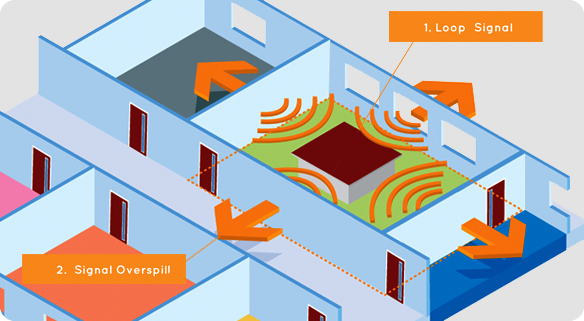Potential Induction Loop Installation Issues
There are a number of key installation issues which can cause problems which in turn will seriously affect the effectiveness of an induction loop. Careful planning and design may be required for certain loop installations which are a function of building construction and room locations.
Metal Loss
The importance of designing Induction Loop systems correctly to cope with losses due to metal structures within the fabric of buildings cannot be over-emphasised. It is absolutely critical to allow for signal loss caused by metal structures during the system planning phase of any installation. If this is not done, the installed loop system is most likely to suffer from a range of problems – insufficient signal strength, uneven signal strength – loud in places and inaudible in others, lack of high frequency detail / clarity or other problems. These problems can be overcome, but only by proper design and attention to detail.
The magnetic field generated by an induction loop system, induces a current in any closed path of a metal structure placed in the vicinity of the induction loop.

These induced currents tend to weaken the magnetic field and cause loss. This loss is dependant on the type and thickness of metal and its position in relation to the induction loop.
- Reinforced concrete floors – often containing a mesh.
- Lightweight floor construction – with a (usually profiled) metal sheet under a thin reinforced concrete slab
- Metal floor tiles – System floors
- Suspended ceiling grid – 600mm x 600mm (2′ x 2′) or 1200mm x 600mm (4′ x 2′) metal grids with acoustic or metal tiles
- Foil backed plasterboard – Vapour barrier
- Girders, beams, constructional metalwork
- Metal cladding, walls and roofs
- Metal counters – Whole or part metal
- Metal box construction – Elevators / lifts
![]()
Overspill
Loops also create a magnetic field that is fairly consistent within the loop and extends outside of the space. Outside of a simple rectangular loop there is still an audible signal as far as 4 times the width of the room away from the loop.

There are many situations where the loop coverage needs to be contained within a specific area, either for security (such as council chambers or courts) or where many rooms exist side by side (such as schools and colleges). For these applications special low overspill designs can be applied to minimise the problem which are the domain of a loop specialist like PAS Sound.
So in order to reduce the spillage from a loop, the solution is usually to use a low spill array arrangement. These loop solutions are a little more complex, but are used widely in theatres, educational establishments, cinemas and conference centres. PAS have developed many low overspill loops and are able to verify predicted overspill prior to commencing installation.










